In this video, Alisa uses the concepts she introduced in Part 1 to improvise on ’Ida Red’ and ‘Cacklin’ Hen.’”
Links to recordings of:
Also see the Apple Music playlist on the main Improvising for Fiddlers and Violinists page.

Check out these songs featured in the Improvising for Fiddlers and Violinists course.
In this eight-session workshop, you’ll learn to improvise and connect to your own creative impulses through musical games, simple exercises, and fiddle tunes. You’ll explore improvisation fundamentals of rhythm and pitch as well as learn how to create and vary melodies, use small building blocks or motifs to build a solo, practice scales and arpeggios, and much more. These exercises can be useful for a musician of any level as they work on fundamental skills of listening deeply, understanding structure and form, and relating to pulse and pitch with awareness.
Alisa’s approach to improvising and practicing improvising was developed from years as a professional musician in a variety of musical contexts, including improvising on fiddle tunes with Scroggins and Rose, improvising for contemporary silent film scores with the Clubfoot Orchestra, improvising with the Real Vocal String Quartet, and as an Improvisation Ensemble instructor at the San Francisco Conservatory of Music. Alisa’s workshop is designed for intermediate-to-advanced violinists and fiddlers but would be worthwhile for players of other instruments as well.
Alisa has this to say about her workshop:
“My path into improvisation was primarily through playful exploring and following my ears. In this workshop we’ll play games that explore isolated fundamental aspects of improvising. I encourage you to approach these exercises, or as I call them games, with a sense of play. Please know you can do no wrong. Play all the weird notes or sounds you want to—it’s part of figuring out what you want to play and freeing yourself from the eternally judging internal critic we musicians tend to have inside at all times. It can be overwhelming to be told to improvise or compose with total freedom, so these games will start with improvising with extreme limits, using only one note, or all notes and no rhythm, and we will build skills from there.”
In this eight-session course, you’ll learn to improvise and connect to your own creative impulses through musical games, simple exercises, and fiddle tunes. You’ll explore improvisation fundamentals of rhythm and pitch as well as learn how to create and vary melodies, use small building blocks or motifs to build a solo, practice scales and arpeggios, and much more.
In this session, Alisa focuses on improvising with one of the fundamental building blocks of music—rhythm. She says, “We will improvise solos with only one note so we can focus on rhythm exclusively. To create structure, phrasing, and interest in solos we’ll explore subdivisions, on and offbeats, space, accents, and bowing patterns. We’ll then apply these concepts to “Stay a Little Longer.”
In the second session, Alisa focuses on another essential element of music—pitch. She says, “Without the pressure of playing in time, we’ll feel how notes relate to a drone (or held pitch) and each other. We’ll explore how different notes have varying amounts of dissonance/consonance or tension/release and how to use that to shape a melodic idea. Using the magical circle of fifths, we’ll play in every key. Then we’ll apply these concepts to “Ida Red,” “Coleman’s March,” and the first part of “Cheyenne.”
In the third session of Improvising for Fiddlers and Violinists, Alisa focuses on improvising with pitch over repeated constant rhythms or groove loops. She says “We’ll find rad rhythms in parts of tunes and words. Over these rhythms, we’ll look at how to choose notes to create compelling shapes and melodies. Then we’ll apply these concepts to improvise on ’Ida Red’ and ‘Cacklin’ Hen.’”
In this session you’ll learn how to improvise over the popular fiddle tune “Goodbye Liza Jane.” Alisa also shows you how to decorate the melody using register shifts, double stops, bowing patterns, neighbor notes, melodic fragments, and other ways to create variations that are still recognizable as the melody.
Learn to improvise with scales and arpeggios! Alisa talks about practicing patterns on scales and then shows you how to incorporate the patterns into “Blackberry Blossom” and “Goodbye Liza Jane.”
Motives are short distinct musical building blocks within a melody. Alisa shows you how to create structure in your improvisations by repeating and altering melodic motives. You will construct interesting solos on “Wheel Hoss” and “Dance Around Molly” by playing their motives in different ways, including slower, faster, higher, lower, longer, shorter, and on different places in the beat.
Whether you are backing up a singer, soloing with a guitar player, or trading roles within a full band, a large part of what makes improvising so dynamic and fun is that it is usually in response to others. In this session, Alisa shows you how to listen and respond to what’s around you as you improvise fills, backup, and a solo on a bluegrass song “Carolina Mountain Home” with guest artist Tristan Scroggins. Tristan and Alisa also demonstrate how to pass ideas back and forth on the fiddle tune “Liberty.”
This week you’ll look at how to structure solos with “question and answer,” and “one two threeee.” Using “New Five Cents” you’ll review and try all the motivic and melodic development techniques and improvisation concepts covered during this course.